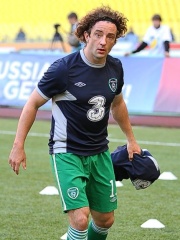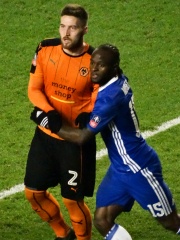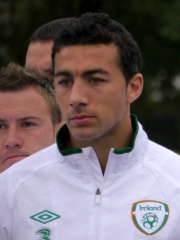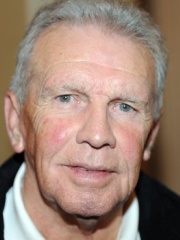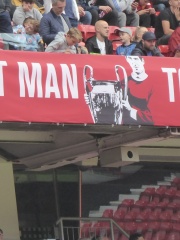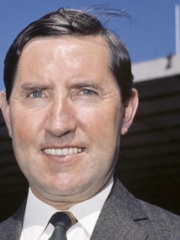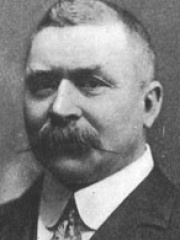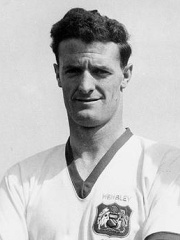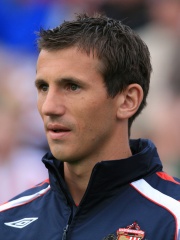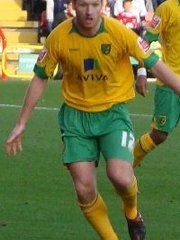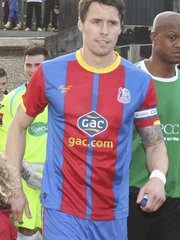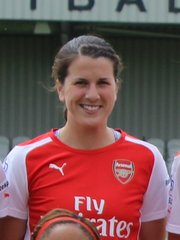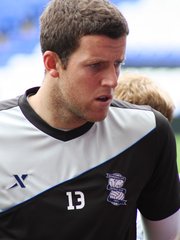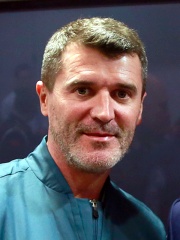
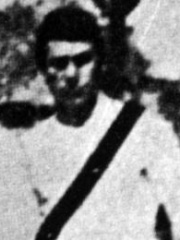
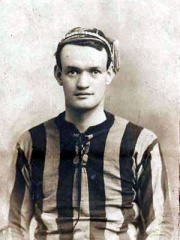
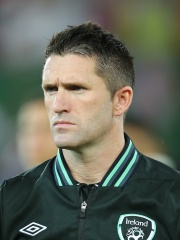

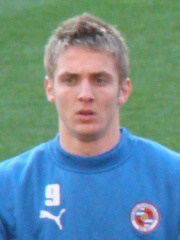
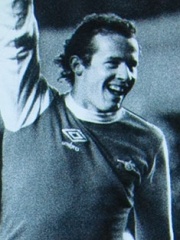
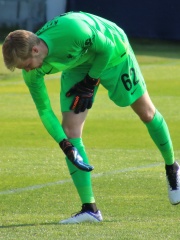
The Most Famous
SOCCER PLAYERS from Ireland
This page contains a list of the greatest Irish Soccer Players. The pantheon dataset contains 21,273 Soccer Players, 83 of which were born in Ireland. This makes Ireland the birth place of the 56th most number of Soccer Players behind Ecuador, and Finland.
Top 10
The following people are considered by Pantheon to be the top 10 most legendary Irish Soccer Players of all time. This list of famous Irish Soccer Players is sorted by HPI (Historical Popularity Index), a metric that aggregates information on a biography's online popularity. Visit the rankings page to view the entire list of Irish Soccer Players.

1. Roy Keane (b. 1971)
With an HPI of 61.21, Roy Keane is the most famous Irish Soccer Player. His biography has been translated into 53 different languages on wikipedia.
Roy Maurice Keane (born 10 August 1971) is an Irish football pundit, former coach, and former professional player. He is best known for his career in the Premier League, in particular his captaincy of Manchester United. He is the joint most decorated Irish footballer of all time alongside Denis Irwin and Ronnie Whelan, having won 19 major trophies in his club career, 17 during his time at Manchester United. Widely regarded as one of the greatest defensive midfielders of all time, one of the best players of his generation, and one of the greatest players in Premier League history, he was named by Pelé in the FIFA 100 list of the world's greatest living players in 2004. In his 18-year playing career, Keane played for Cobh Ramblers, Nottingham Forest, and Manchester United, before ending his career at Celtic. He was a dominating box-to-box midfielder noted for his aggressive and highly competitive style of play, an attitude that helped him excel as captain of Manchester United from 1997 until his departure in 2005. Keane helped United achieve sustained success during his 12 years at the club, winning seven Premier League titles, four FA Cups, and the UEFA Champions League. He then signed for Celtic, where he won the Scottish Premier League and Scottish League Cup before retiring as a player in 2006. Keane played at the international level for the Republic of Ireland over 14 years, most of which he spent as captain. At the 1994 FIFA World Cup, he played in every Republic of Ireland game. He was sent home from the 2002 FIFA World Cup after a dispute with national coach Mick McCarthy over the team's training facilities. Keane began his management career at Sunderland shortly after his retirement as a player and took the club from 23rd position in the Football League Championship, in late August, to winning the division title and gaining promotion to the Premier League. He resigned in December 2008, and from April 2009 to January 2011, he was manager of Championship club Ipswich Town. In November 2013, he was appointed assistant manager of the Republic of Ireland national team by manager Martin O'Neill, a role he held until 2018. He also had brief spells as assistant manager at Aston Villa in 2014 and Nottingham Forest in 2019. Following his departure as manager of Ipswich, Keane began a career in the media working for British channels ITV and Sky Sports as an in-studio football analyst. He was inducted into the Premier League Hall of Fame in 2021.

2. Arthur Johnson (1879 - 1920)
With an HPI of 60.60, Arthur Johnson is the 2nd most famous Irish Soccer Player. Her biography has been translated into 18 different languages.
Arthur Vere Scott Johnson (31 August 1878 – 23 March 1929) was an Irish coach and footballer who played as both a forward and goalkeeper for Madrid FC. He was one of the most important figures in the amateur beginnings of Real Madrid CF, since it was the knowledge that he brought from a more advanced football in England that helped the club to have a rapid sporting growth in its early years, thus being one of the main architects of the foundations that saw the club win its first titles and become one of the best teams in the country in the early 20th century. Johnson was also a historic player of Real Madrid, having been part of the first-ever team fielded by them in 1902 and then serving as the club's first coach for ten years, between 1910 until 1920.

3. Patrick O'Connell (1887 - 1959)
With an HPI of 60.21, Patrick O'Connell is the 3rd most famous Irish Soccer Player. His biography has been translated into 17 different languages.
Patrick Joseph O'Connell (8 March 1887 – 27 February 1959), also known as Paddy O'Connell or Patricio O'Connell, was an Irish football player and manager. A wing half, he played for Belfast Celtic, Sheffield Wednesday, Hull City and Manchester United. He has the distinction of being the first player from what is now the Republic of Ireland to play for and captain Manchester United. As an international, he captained Ireland and was a member of the team that won the 1914 British Home Championship. However, O'Connell is probably best remembered for managing several clubs in La Liga. In 1935 he led Real Betis to their first La Liga title, and during the Spanish Civil War he took Barcelona on a tour of North America. Despite these successes, he died destitute in London in 1959 and was initially buried in an unmarked grave at St Mary's Catholic Cemetery, Kensal Green, London NW6.

4. Robbie Keane (b. 1980)
With an HPI of 59.13, Robbie Keane is the 4th most famous Irish Soccer Player. His biography has been translated into 59 different languages.
Robert David Keane (born 8 July 1980) is an Irish professional football coach and former player, currently the head coach of Hungarian club Ferencváros. Keane played as a striker, and was captain of the Republic of Ireland from March 2006 until his international retirement in August 2016. He is the most capped player and top goalscorer for Ireland. Keane began his career at Wolverhampton Wanderers, scoring twice on his first-team debut aged 17. The following season, he was the club's leading goalscorer and scored his first international goal for Ireland. He changed club frequently between 1999 and 2002, breaking transfer fee records, but his brief spells at Inter Milan and Leeds United were unexceptional. He joined Tottenham Hotspur in 2002 and played there for seven and a half years over two spells, amassing 306 appearances and 122 goals across all competitions. The 2007–08 season was the most fruitful of his career as he set a career record of 23 goals in a season, including a landmark 100th competitive goal, and won his first senior honour (the League Cup). Keane moved to Liverpool in July 2008 but he spent only six months at the club before returning to Tottenham, where he was made first team captain. In January 2010, he moved on loan to Scottish Premier League side Celtic for the rest of the season, and spent the second half of the following season loaned to West Ham United. He left Tottenham for LA Galaxy in 2011, and in January 2012 went to Aston Villa on a two-month loan during the Major League Soccer (MLS) off-season. He departed LA Galaxy in 2016 having scored 104 goals across six seasons, before a short stint with Indian club ATK. Keane announced his retirement from professional football in November 2018. In total, he scored 126 Premier League goals for six clubs, which ranks him as the 17th-most successful goalscorer in the history of the Premier League. Widely regarded as one of the best Irish players of all time, Keane scored 68 goals for the Republic of Ireland national team over an 18-year international career, making him the all-time record Irish scorer. His 146 caps is also an Irish record. Keane is the joint seventh-highest European international goalscorer of all time, and the only player in the history of world football to have scored at least one international goal in 19 consecutive years. Keane was the Republic of Ireland's top scorer at the 2002 FIFA World Cup with three goals as they reached the last 16, and also played at UEFA Euro 2012 and UEFA Euro 2016. Throughout his club and international career he was known for his goal celebration where he performed a cartwheel followed by a forward roll. After announcing his retirement from playing, Keane began his coaching career with the Ireland senior team as assistant manager under Mick McCarthy's management setup in November 2018. He also took on the role of assistant manager at Championship club Middlesbrough in 2019, with his former teammate Jonathan Woodgate as manager. He left both roles in 2020. He became the head coach of Maccabi Tel Aviv in June 2023, winning the Israeli Premier League and Toto Cup in his only season. He became the manager of Ferencvaros in January 2025 and won the Hungarian title at the end of the season.
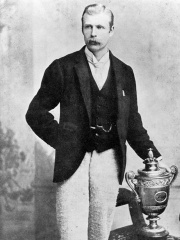
5. Willoughby Hamilton (1864 - 1943)
With an HPI of 56.01, Willoughby Hamilton is the 5th most famous Irish Soccer Player. His biography has been translated into 20 different languages.
James Willoughby Hamilton; (9 December 1864 – 27 September 1943) was a co-world No. 1 Irish male tennis player, a footballer and international badminton player.

6. Brian Kerr (b. 1953)
With an HPI of 54.63, Brian Kerr is the 6th most famous Irish Soccer Player. His biography has been translated into 17 different languages.
Brian Kerr (born 3 March 1953) is an Irish football manager. Born in Dublin, Kerr grew up playing football and boxing. At the age of 13, he took his first coaching role with the Crumlin United under-11 side. Realising later that he didn't have the talent to become a top player, he decided to focus on coaching. In 1986, he was appointed manager of the League of Ireland side St Patrick's Athletic. In 1992, when the club was facing liquidation, Kerr was among the investors who raised IR£82,000 to help save the club. In December 1996, he left St Patrick's to become the technical director of the Football Association of Ireland. Kerr worked with the Republic of Ireland youth squads and also with the senior side. He was appointed as the full-time manager of the senior Ireland team on 26 January 2003. In 2007, Kerr became the Director of Football of St. Patrick's Athletic. Then, in 2009, he was confirmed as the head coach of the Faroe Islands national team. He left that post in October 2011.

7. Kevin Doyle (b. 1983)
With an HPI of 54.47, Kevin Doyle is the 7th most famous Irish Soccer Player. His biography has been translated into 35 different languages.
Kevin Edward Doyle (born 18 September 1983) is an Irish former professional footballer who played as a forward. He played for Wexford F.C. (formerly Wexford Youths), St Patrick's Athletic, and Cork City in his homeland before he moved to English side Reading. He was part of Reading's record-breaking promotion to the Premier League in 2006. In June 2009, he moved to Wolverhampton Wanderers for a then-club record £6.5 million and finished his career in the United States with the Colorado Rapids. Doyle made his debut for the Republic of Ireland national team in 2006. He scored fourteen goals in 62 appearances for Ireland and represented the country at UEFA Euro 2012. In February 2018, Doyle took a job with the Wexford GAA Under-20s football team as an advisor to the team.

8. Liam Brady (b. 1956)
With an HPI of 53.94, Liam Brady is the 8th most famous Irish Soccer Player. His biography has been translated into 28 different languages.
William Brady (born 13 February 1956) is an Irish former footballer and pundit. He found success both in England with Arsenal, where he won an FA Cup in 1979, and in Italy with Juventus, winning two Serie A titles. Brady was capped 72 times for the Republic of Ireland national team. Brady was a talented attacking midfielder renowned for his left foot and elegant technical skills such as his high-quality passing, vision and close control, which made him an excellent playmaker. Brady went on to manage Celtic and Brighton and Hove Albion. He was the assistant manager of the Republic of Ireland national football team from 2008 to 2010 and also held the post of Head of Youth Development at Arsenal from 1996 to 2013. He began his media career as a television pundit in 1990 with the BBC, before moving to RTÉ Sport in 1998. In June 2023, Brady announced that he would step down from his punditry duties with RTÉ after 25 years.

9. Caoimhín Kelleher (b. 1998)
With an HPI of 53.80, Caoimhín Kelleher is the 9th most famous Irish Soccer Player. His biography has been translated into 32 different languages.
Caoimhín Odhrán Kelleher (Irish: [ˈkiːvʲiːnʲ ˈoːɾˠaːnˠ ˈkɛlɪhəɹ] KEE-veen OR-ən KELL-e-her; born 23 November 1998) is an Irish professional footballer who plays as a goalkeeper for Premier League club Brentford and the Republic of Ireland national team. Kelleher is a graduate of Liverpool’s youth academy and made his senior competitive debut for the club in September 2019. He then emerged as the back-up goalkeeper to Alisson Becker, gaining a reputation as a talented shot-stopper and penalty specialist. During his time at Liverpool, he won the Premier League, the FA Cup, the UEFA Champions League and the resultant UEFA Super Cup. He also won the EFL Cup twice; in the 2021–22 and 2023–24 seasons. In 2025, Kelleher signed for Brentford in a transfer reportedly worth £12.5 million. Kelleher made his senior Ireland debut in June 2021 and has since represented his nation in the UEFA Nations League.
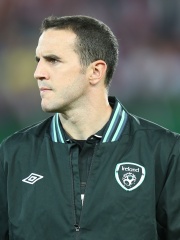
10. John O'Shea (b. 1981)
With an HPI of 53.69, John O'Shea is the 10th most famous Irish Soccer Player. His biography has been translated into 55 different languages.
John Francis O'Shea (; born 30 April 1981) is an Irish professional football coach and former player who is currently assistant manager of the Republic of Ireland men's national team. He was known for his versatility in playing several defensive and midfield positions on either side of the pitch or the centre. With 14 winners' medals, he is one of the most decorated Irish footballers of all time; only Denis Irwin, Roy Keane, Steve Heighway and Ronnie Whelan have accrued more honours. Born in Waterford and growing up in Ferrybank, O'Shea joined Manchester United when he was 17. He spent loan spells at AFC Bournemouth and Royal Antwerp before establishing himself in the Manchester United first team, going on to make 393 appearances and scoring 15 times in all competitions across 12 seasons. He won five Premier League titles, one FA Cup, two Football League Cups, four FA Community Shields, the FIFA Club World Cup and the UEFA Champions League with the club. He joined Sunderland in July 2011. Having played 256 times for the Wearside club and scoring four goals, he signed for Championship side Reading in July 2018. Retiring in May 2019, he joined that club's coaching staff that summer, before leaving in the summer of 2021. He then coached at Stoke City and Birmingham City. O'Shea made his Republic of Ireland debut in 2001 against Croatia and made 118 appearances for his national team over the next 17 years, scoring three goals, his first in 2003 against Australia. He was part of the team that controversially lost to France in a play-off for the 2010 FIFA World Cup and went on to play in UEFA Euro 2012 and UEFA Euro 2016. He then served as assistant manager on the under-21 and senior teams, as well as interim manager of the latter in 2024.
People
Pantheon has 83 people classified as Irish soccer players born between 1855 and 2004. Of these 83, 74 (89.16%) of them are still alive today. The most famous living Irish soccer players include Roy Keane, Robbie Keane, and Brian Kerr. The most famous deceased Irish soccer players include Arthur Johnson, Patrick O'Connell, and Willoughby Hamilton. As of April 2024, 6 new Irish soccer players have been added to Pantheon including Katie McCabe, Gary Doherty, and Stephen O'Halloran.
Living Irish Soccer Players
Go to all RankingsRoy Keane
1971 - Present
HPI: 61.21
Robbie Keane
1980 - Present
HPI: 59.13
Brian Kerr
1953 - Present
HPI: 54.63
Kevin Doyle
1983 - Present
HPI: 54.47
Liam Brady
1956 - Present
HPI: 53.94
Caoimhín Kelleher
1998 - Present
HPI: 53.80
John O'Shea
1981 - Present
HPI: 53.69
Stephen Hunt
1981 - Present
HPI: 53.43
Gary Kelly
1974 - Present
HPI: 52.98
Matt Doherty
1992 - Present
HPI: 52.11
Stephen Kelly
1983 - Present
HPI: 50.77
Johnny Giles
1940 - Present
HPI: 50.45
Deceased Irish Soccer Players
Go to all RankingsArthur Johnson
1879 - 1920
HPI: 60.60
Patrick O'Connell
1887 - 1959
HPI: 60.21
Willoughby Hamilton
1864 - 1943
HPI: 56.01
Tony Dunne
1941 - 2020
HPI: 52.86
Frank O'Farrell
1927 - 2022
HPI: 52.67
John McKenna
1855 - 1936
HPI: 52.17
Billy Whelan
1935 - 1958
HPI: 51.99
Johnny Carey
1919 - 1995
HPI: 50.32
Liam Miller
1981 - 2018
HPI: 38.29
Newly Added Irish Soccer Players (2025)
Go to all RankingsKatie McCabe
1995 - Present
HPI: 29.72
Gary Doherty
1980 - Present
HPI: 29.31
Stephen O'Halloran
1987 - Present
HPI: 27.55
Paddy McCarthy
1983 - Present
HPI: 27.14
Niamh Fahey
1987 - Present
HPI: 25.56
Colin Doyle
1985 - Present
HPI: 25.09
Overlapping Lives
Which Soccer Players were alive at the same time? This visualization shows the lifespans of the 7 most globally memorable Soccer Players since 1700.

